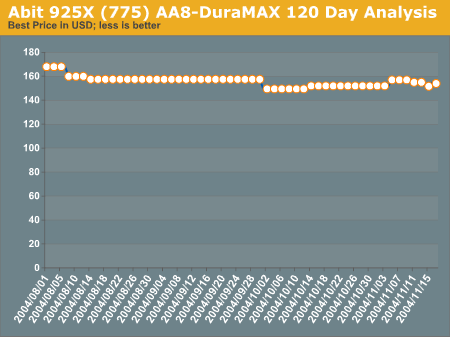
Original Link: https://www.anandtech.com/show/1547
Price Guides November 2004: CPU and Motherboards
by Adam Rader on November 18, 2004 12:05 AM EST- Posted in
- Guides
Introduction
Motherboards and processors have been the most active components with respect to PC hardware advances and development over the years. This has become even more apparent in the last year during which Intel and AMD both rolled out new sockets, new chipsets and new ways of computing. It's now very easy to create a system, or upgrade an old one, to incorporate enough computing power to make NASA of the 1960's wish that they were you. With that in mind, you can see how overkill can be had very easily and how obsolescence can be had just as easily.We'll take a look at what's available on the market and try to find out which motherboard and/or processor makes the most sense for your needs while, hopefully, steering safely clear of buying instantly obsolete hardware.
As always, make sure that you take a look at our RealTime Pricing Engine to get up-to-date prices on everything that you see in this guide and more.
AMD Processors - Athlon 64
PC gaming is one of the areas that drives a very large percentage of hardware purchases. AMD knows this and they currently lead the pack in gaming performance with their Athlon 64 lineup of processors. Even without running a 64-bit operating system or even applications, it's possible to get leading performance in a wide variety of PC game titles from these chips. As soon as Microsoft has Windows XP 64 ready for the public, and hardware vendors create functional drivers for their devices to run in this new environment, it will only help boost the longevity of any Athlon 64 processor purchased today.The really good news for these high-performance chips is that they are not terribly expensive and are widely available - two facts that don't come together as a mere coincidence.
Socket 754
This week's top pick for an entry-level Athlon 64 goes to the Athlon 64 2800+ (Newcastle/Socket 754), which is available for as low as $120. The actual clock speed of the 2800+ is 1.8GHz and has shown itself to be a great choice as an entry into the 64-bit world as well as for gaming and general desktop usage.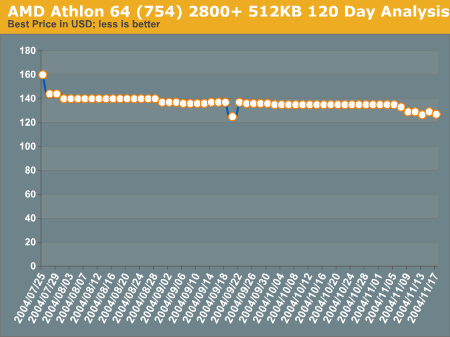
Socket 939
Socket 939 has started to become a bit more attractive lately as prices have been on a downward trend these last few weeks. To top that off, the K8T800 Pro chipset has become more widely available on motherboards while NVIDIA is just starting to bring nForce4 to market. Granted, 939 has always held a bit more leverage, since, unlike socket 754 chips and boards, it isn't going anywhere anytime soon.To keep things relatively affordable, as well as preventing extreme levels of overkill on both power and price, the AMD Athlon 64 3200+ (Winchester/Socket 939) comes out as the top choice. This chip does a pretty good job of balancing the power to performance scale and throws in the fact that the 939 platform is the one that AMD plans to keep around long enough to realize higher clock speeds. This makes for a stable future upgrade path that should keep you from feeling buyer's remorse a year or so down the road. The 3200+ is already clocked at 2.0GHz and, when paired up with the right motherboard, is capable of some nice overclocks.
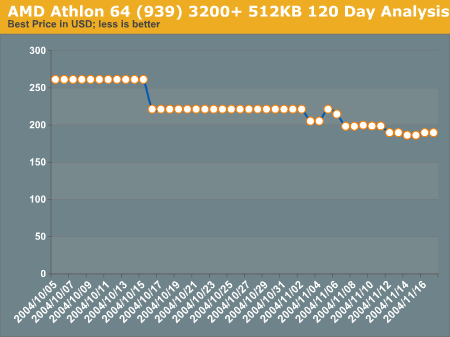
AMD Processors - Athlon XP
Two factors often ring true of enthusiasts and system builders. They like technologies that have been around for a while and are proven, and they like to get the most that they can get out of existing hardware. The Athlon XP still serves both of these purposes very well, whether you are building a new system from scratch or you just want to upgrade your existing Socket A chip. With the introduction of Athlon 64 and Sempron products from AMD, Athlon XP prices are only going to get lower and lower.Since prices are low, and because the Athlon XP doesn't have an infinite amount of time left to live, we have raised the standards a bit for this week's recommendation. The Athlon XP 2800+, available for less than $100, is a chip that can provide a noticeable bump in gaming and high-end performance for a lot of users who are running older non-Barton processors. The price to performance ratio on this chip is also one worth checking out if you don't really want to deal with upgrading to a new socket, motherboard and processor all at once. Picking out a lower processor, such as a 2500+ or even 2000+ is a great way to build a basic system as well.
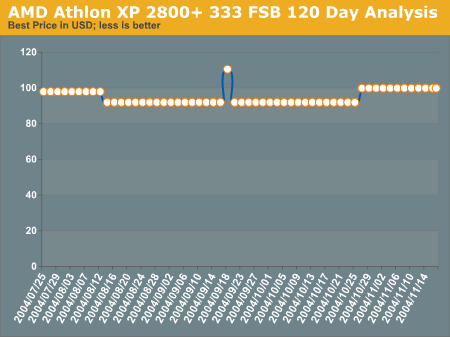
AMD Processors - Sempron
Sempron is AMD's newest kid on the block and will eventually overshadow and replace the Athlon XP for budget system builds, basically becoming the new Duron while the Athlon 64 takes the reins as top-performer.When an A64 can be had for so little, it is a bit challenging to find a reason to stray from it - yet, everyone has their reasons. Certain Sempron models will allow you to utilize socket 754 motherboards, which means more upgradeability down the road versus the future options of socket A. Currently, this is limited to the Sempron 3100+, but more will arrive as AMD releases them. In the meantime, the Sempron is best suited for the average user who just needs a place to check email, browse the web, and chat with family and friends online. The Sempron 2200+, which is a socket A chip, is currently available for under $50 and should work very well for many users who don't need high end gaming, or expect to compete with a supercomputer cluster. This is a price-point, which makes building a simple rig very affordable, especially since socket A motherboards are so widely available and prices for those same motherboards can also be extremely low.
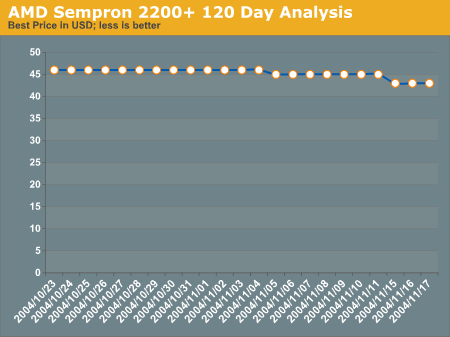
Intel Processors - Socket 775
With the release of the P4 570J (3.8GHz), Intel shows that they are serious about the new socket 775 and the end of 478 in the near future. Of course, the 570J also shows that Intel's high-clock chips tend to be the very same space heaters that AMD chips were once known to be. This is likely to become even more of an issue as Intel gears up for their dual core processors.Regardless of heat output, which isn't an issue for the majority of buyers out there, both AMD's and Intel's top-end processors are running neck-and-neck for performance depending on what applications you utilize on them. Intel always has been, and still is, the leader for media encoding and content creation. So, unless gaming is your key target, Intel is definitely a good place to pick up a processor.
This week's best value comes to us in the form of a 2.8GHz Pentium 4, which carries the model number 520. The price on this processor is very reasonable, considering that it is sitting atop Intel's newest socket and chipset and will make for the most flexible upgrade path in the future.
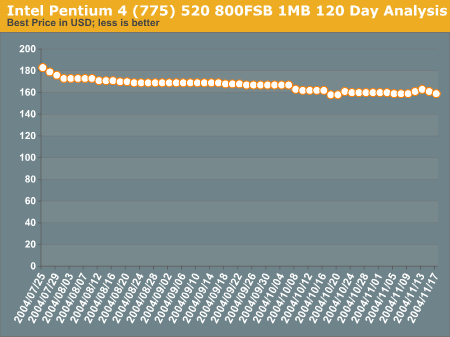
If you want a bit of a boost in performance, for about $40 more, you can pick up the 3.2GHz version of this chip - the Pentium 4 540. Both chips will likely be more than enough to keep your machine going at full tilt for a long time without having to worry much about upgrading over and over again. Going with a chip any higher will decrease the cost to benefit ratio of the purchase by a good margin and in the end, will not be as much of a value on a dollar for dollar basis.
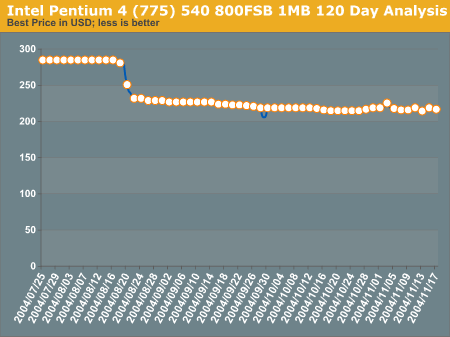
Intel Processors - Socket 478
Much like the AMD camp who has plenty of users not interested in buying a new motherboard, and various other components, but rather the latest and greatest processors offered, the 478-based P4 still has enough life left in it to be a viable option for upgrading or even building a new system. Unless you wish to fork over money for a new motherboard, and quite possibly a new video card and new RAM, then socket 478 is still the way to go.Just short of the $200-mark is the Intel Pentium 4 (478) 3.0GHz 800FSB 512KB. $200 may be a somewhat high price point for a processor, which is going to have its socket decommissioned in a short period of time, but that price is still very much lower than the potential cost to adopt socket 775 in one fell swoop. There's also no difference in the processor architecture itself that really warrants moving to 775 right now and this makes 478 want to stick around a little longer while it still can.
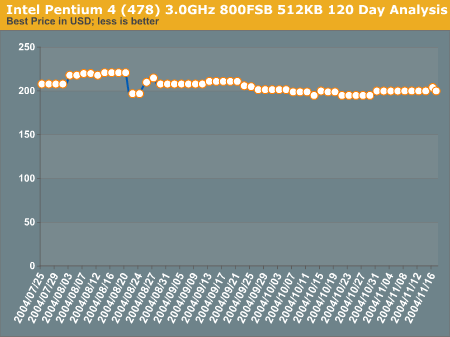
Intel Processors - Celeron
While AMD continues to push Sempron out to the world, Intel has rather quietly upgraded their Celeron lineup with a new core (Prescott) to help boost its viability in budget desktop systems. Ever since this core change, the Celeron has had new life breathed into it in such a way that makes it a chip worth choosing, if high-end performance is not of paramount importance. It also helps that these chips still operate on socket 478 and would not invoke the high costs of 775.The Intel Celeron D (478) 330, which is a 2.66GHz processor, is more than sufficient for basic desktop use and competes well with AMD's Sempron lineup of processors. Likewise, this processor is priced at a level that should be affordable to even the most budget-conscience users out there.
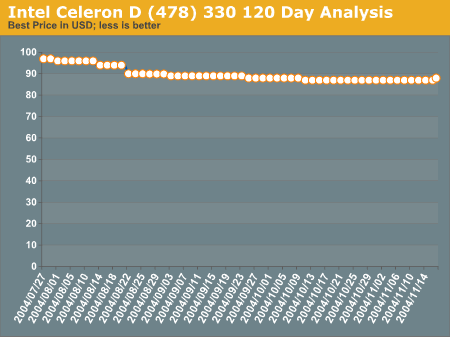
AMD Motherboards - NVIDIA nForce 2
NVIDIA's nForce2 chipset has been around for a little while now and has had plenty of time to prove itself to the community at large. Luckily for NVIDIA, it proved itself and did so very well, emerging as one of the best socket A chipsets ever produced. While there are some variants to the NF2 chipset that have been released after the fact, it is hard to go wrong with any of them when looking to purchase a new motherboard.One board in particular that has held on strong as being great for overclocking, stability, overall speed and features is the Abit NF7-S. Although it may not carry onboard gigabit Ethernet, or a dual BIOS as some do, these are features that are less than necessary when the goal is to build a rock solid machine for a reasonable price.
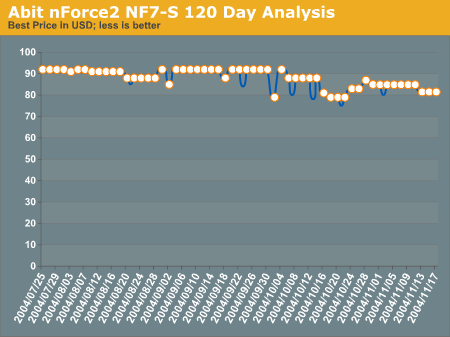
AMD Motherboards - NVIDIA nForce 3
nForce 3 has been and still is the best option for overclocking an Athlon 64. While chipsets from Via are built more for stability and stock speeds, nForce 3 tends to be packed with more features and settings to allow for tweaking to get absolutely the most out of your new processor.Socket 754
Socket 754 has started to move into a value or budget area as AMD pushes to get 939 out the door and onto store shelves. Since 754 can take an Athlon 64 or a Sempron, however, it does have the unique advantage of being quite flexible on the choice of processors that are available at least for now. The DFI nForce3 250 (754) LanParty UT board continues this week as a favorite option for the 754 platform.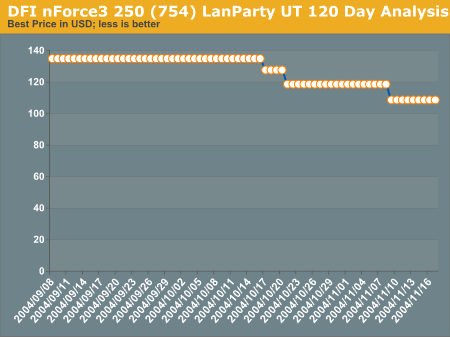
Socket 939
nForce 4 boards should also be coming out very shortly. A good preview of nForce 4 can be found in our recent review of the Gigabyte K8NXP-9. In the meantime, socket 939 still has a home with the MSI nForce3 Ultra (939) K8N Neo2 Platinum. Fully loaded with every audio option imaginable, SATA, RAID, and Marvell's gigabit Ethernet controller (along with a second gigE controller from Realtek), it's safe to say that this board is among the best of the best.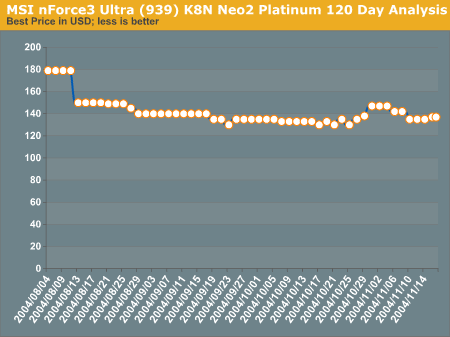
AMD Motherboards - Via K8T800
Via continues their K8T800-based motherboard lineups with new releases from both Epox (9NDA3+) and Soltek (SL-K8TPro-939), which only help to expand the possibilities for those looking to get onboard the Athlon 64 bandwagon. On top of that, prices for Via-based A64 boards seem to be coming down little by little, not that they were ever the most expensive options from the beginning. In the end, more choice is a great thing for everyone and board makers seem to be on a roll now with no end in sight.Socket 754
The MSI K8T800 (754) Neo-FIS2R still shows up this week as a high-value, low-cost motherboard that would work well for any new system build where overclocking isn't the primary objective. Our past review of this board shows that the Neo-FIS2R is a fully loaded board sporting everything from gigabit LAN, RAID, firewire, LED-based diagnostics, and 5.1 audio with a plethora of inputs and outputs, all in a great layout that would work well for just about any case design today. The performance of this board is also top-notch, giving you the most out of your socket 754 chip. This is important, since 754 will not have as long of a CPU upgrade path as 939. So, getting as much as possible from 754 only helps to bring more value to the table.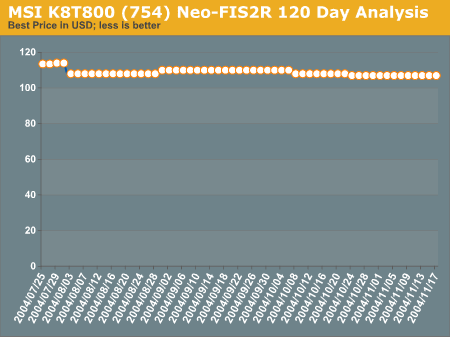
Socket 939
For those looking to get the latest and greatest, as well as take advantage of AMD's newer 90nm parts, the Abit K8T800 Pro (939) AV8 board is where it's at. This one has everything that we have come to expect from a motherboard today, including gigabit LAN, SAT, firewire, onboard 5.1 sound, and high-end performance.
Intel Motherboards - 8xx
With socket 755 sales turning out at less than spectacular levels, 8xx-based boards, those which run from the older socket 478, have proven to be a tough nut to crack when it comes to retiring the old and ushering in the new. This isn't a bad thing at all, since 8xx-based boards have been around for a while and have had all the time in the world to prove their stability and performance to us.Abit's own 875P implementation, the IC7-G MaxII, has been on the scene for long enough to know that its performance is exactly what Intel buyers demand from a motherboard. Again, lower price wins out as the Abit manages to undercut the prices on other top-end boards, including MSI's Neo-FIS2R, which is also an 875P chipset-based board.
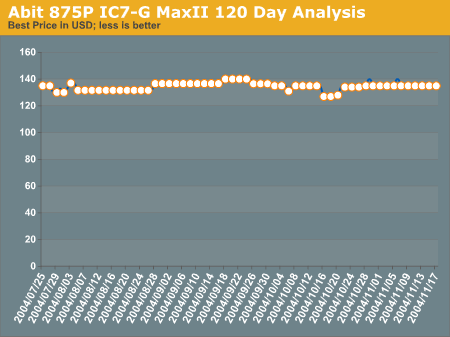
Intel Motherboards - 9xx
Intel chipset based motherboards have always had the advantage of very tight integration with the CPU, since the chip and chipset were made by the same company. This has always helped Intel keep everything running smoothly while controlling a few more variables. Unfortunately, even that level of granular control hasn't been enough to push buyers towards the new 915/925 based boards. Anand's recent trip to Taiwan reveals that economic conditions here in the US (and even worldwide), and more importantly, the costs of adopting DDR2 and PCI Express video cards, are all hurting the new platform's adoption rate. In the end, we still don't fully recommend making the switch to these new chipsets, and their accompanying costs, just yet. Until performance on the new platform can start to compete better with 865-based systems, as well as AMD's latest offerings, it's best to stick to the tried and true. PCI Express and DDR2 have yet to offer anything in the way of real benefit and until they do, 915/925 will continue to be more for show than for real substance.On the other hand, show and bragging rights are a major reason why a lot of enthusiasts upgrade to the latest and greatest. So for those, we do recommend the Abit AA8-DuraMAX. For what it's worth, it's one of the best performers around for the 925 chipset and isn't priced badly at all, considering that it supports all of the newest technologies that Intel is pushing.
